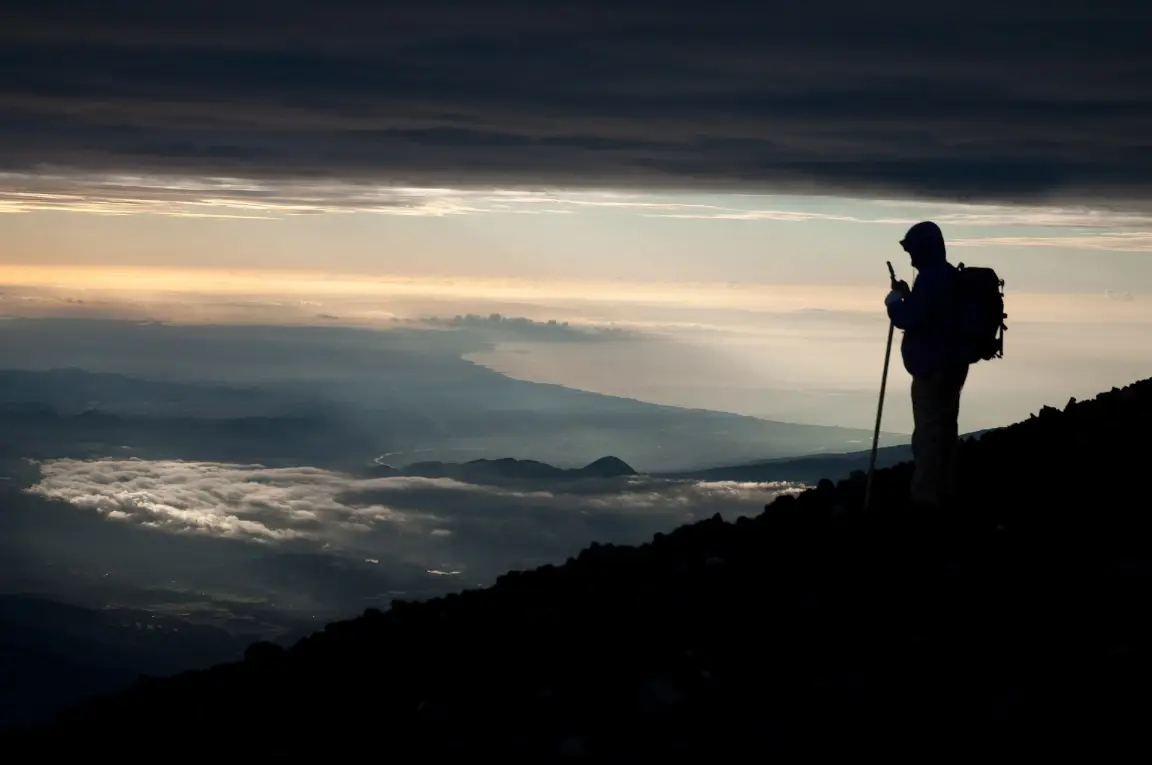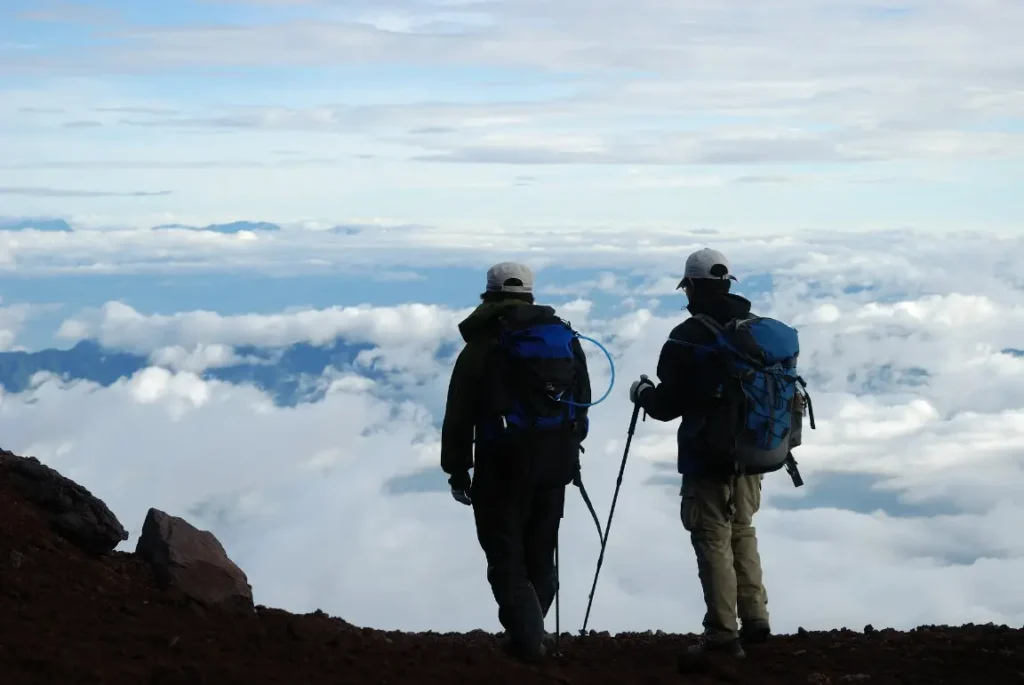Climbing Mount Fuji is a trip across Japan’s natural beauty, cultural legacy, and spiritual core, not only a walk. Mount Fuji presents not only amazing views but also a fulfilling sense of accomplishment since it is the highest peak in Japan. You are in the ideal place if you are organizing your first trip up this famous mountain. All the required climbing guidance, path specifics, and insider knowledge from this Mount Fuji hiking guide will help you to have a fantastic trip to the top.
Mount Fuji Overview
Rising majestically at 3,776 meters, Mount Fuji, sometimes known as “Fuji-san,” dominates the surrounding terrain. Particularly on a clear day, it can easily seen from miles away from Tokyo on Honshu Island, about 100 kilometres southwest. In Japan, the mountain has great cultural and spiritual value that motivates adventurers, poets, and painters. The adventure starts long before you even set foot on the paths for first-time mounters. A good ascent depends mostly on proper preparation and knowledge of the subtleties of the mountain.

When to Climb Mount Fuji: Understanding the Climbing Season
Timing is everything when it comes to climbing Mount Fuji. The official Mt. Fuji climbing seasons span from early July through early September. The weather is rather pleasant around this time, and the paths are free of snow, so the ascent is safer and more approachable for novers. During this time, all mountain huts, rest stations, and facilities are also operational, providing ease and assistance for your climb.
Climbing outside this season is quite discouraged because of perilous circumstances including freezing temperatures, heavy snowfall, and lack of support facilities. If you have never climbed before, follow the official season for a safer and more fun trip.
Fuji Mountain Trails: Which One Is Right for You?
Four primary paths lead to the summit, each with particular difficulties and breathtaking views. A key first step in your Mount Fuji hiking guide is selecting the appropriate path.
Yoshida Trail (Yellow)
Starting Point: Fuji Subaru Line 5th Station.
Difficulty: Beginner-friendly, suitable for most first-time climbers.
Distance: Approximately 6.2 km to the summit.
Highlights: With many of mountain cabins, bathrooms, and supplies accessible, this trail is the most often used one. Additionally among the best places to see the Fuji summit sunrise is this trail.
Ideal For: First-time hikers who want a well-supported climb.
Subashiri Trail (Red)
Starting Point: Subashiri 5th Station.
Difficulty: Moderate, with a tranquil path through lush forests.
Distance: Approximately 8 km to the summit.
Highlights: Fewer crowds and picturesque woodland scenery.
Ideal For: Climbers looking for a quieter experience with natural beauty.
Gotemba Trail (Green)
Starting Point: Gotemba 5th Station.
Difficulty: Challenging due to its length and steep gradients.
Distance: Approximately 11 km to the summit.
Highlights: The least crowded trail, offering solitude and a sense of wilderness. The descent on this trail is notable for its long stretches of volcanic sand.
Ideal For: Experienced hikers seeking an isolated and physically demanding hike.
Fujinomiya Trail (Blue)
Starting Point: Fujinomiya 5th Station.
Difficulty: Moderate to challenging, with a steep incline.
Distance: Approximately 5 km to the summit.
Highlights: The shortest yet steepest route to the summit.
Ideal For: Those who prefer a shorter but more intense climb.
Preparing for the Climb
Successful ascent depends on proper preparation. These basic climbing Mt. Fuji tips will help you be ready for the trip.
Essential Gear
Layered Clothing: At the summit, the weather could be frigid and gusty. Add or subtract as necessary from breathable, moisture-wicking layers.
Sturdy Footwear: To negotiate the rocky terrain and loose volcanic gravel, use hiking footwear with strong ankle support.
Headlamp: If you want to hike pre-dawn to see the Fuji summit sunrise, you really must bring a headlamp.
Trekking Poles: Trekking Poles are helpful for balancing and lessening knee strain during both ascent and descent.
Waterproof Gear: Mountains’ abrupt change in weather can To keep dry, pack a lightweight, waterproof jacket.
Backpack: Carry water (at least 2 litres), food, sunscreen, sunglasses, gloves and a basic first aid kit in your backpack.
Acclimatization and Climbing Pace
Spend some time at the fifth station adjusting to the elevation.
To avoid altitude sickness, climb carefully and stop often. Many mounties advise the “pole, pole” pace, which translates in Swahili as “slowly, slowly.
Planning Your Ascent: Day Climb vs. Overnight Climb
Day Climb: Start early in the morning, maybe at 7–8 a.m., to make sure you get back before eveningfall. Experienced hikers who are sure of their physical stamina will find this alternative most suitable.
Overnight Climb: Start in the evening, stop halfway up at a mountain cabin, and then start the climb again between two and three a.m. This schedule lets you see the amazing Fuj Summit sunrise. For first-timers, the overnight climb is usually advised since it divides the travel and enhances the whole experience.
Mountain Huts: Your Rest Stop on the Way to the Summit
Mountains cottages offer a great place to stop throughout the climb. Especially in August, when the demand is highest, booking a hut in advance is absolutely vital. The cottages provide meals and rudimentary sleeping quarters. Prices vary depending on the location and services rendered from ¥5,000 to ¥10,000 per person. Before your last push to the top, these huts provide an opportunity for rest, acclimatize, and replenish.
Reaching the Summit for Sunrise: Fuji Summit Sunrise
Among the pleasures of hiking Mount Fuji is the stunning Fuji summit sunrise, sometimes known as “Goraiko.” Starting your last climb from the mountain lodge at about two to three a.m., you are hoping to catch this amazing sight. Because the climb is difficult in the dark, be sure your headlamp has fresh batteries. The sky starts to get lighter as you ascend, providing unique pink, purple, and gold tones. Seeing the sunrise above the sea of clouds is quite impressive.
The Descent: What You Need to Know
The descent is often underestimated but can be just as challenging as the ascent. Follow the designated descending paths for each trail:
Yoshida Trail has a separate descent route covered with loose gravel, making it slippery.
Subashiri Trail features a sandy terrain that allows for a quicker descent but can be tough on the knees.
Gotemba Trail offers a long, sandy descent that some hikers find exhilarating.
Take your time, use your trekking poles, and don’t rush. A safe descent is just as important as reaching the summit.
Climbing Mt. Fuji Tips for First-Time Hikers
Hydration: Drink water regularly, but in small sips to avoid dehydration.
Cash: Bring enough cash for mountain huts, snacks, and restrooms, as credit cards are not widely accepted on the mountain.
Respect Nature: Pack out all your trash and respect the environment.
Stay Informed: Keep an eye on weather conditions and trail updates.
Conclusion
Once-in-a-lifetime opportunity, climbing Mount Fuji offers amazing views and a terrific sense of achievement. Following this Mount Fuji hiking guide and the climbing tips given will allow you to be ready for a safe and wonderful trip to the summit of Japan. Whether your aim is the Yoshida Trail or the Fuji Summit sunrise, the experience is probably one you will always appreciate.

